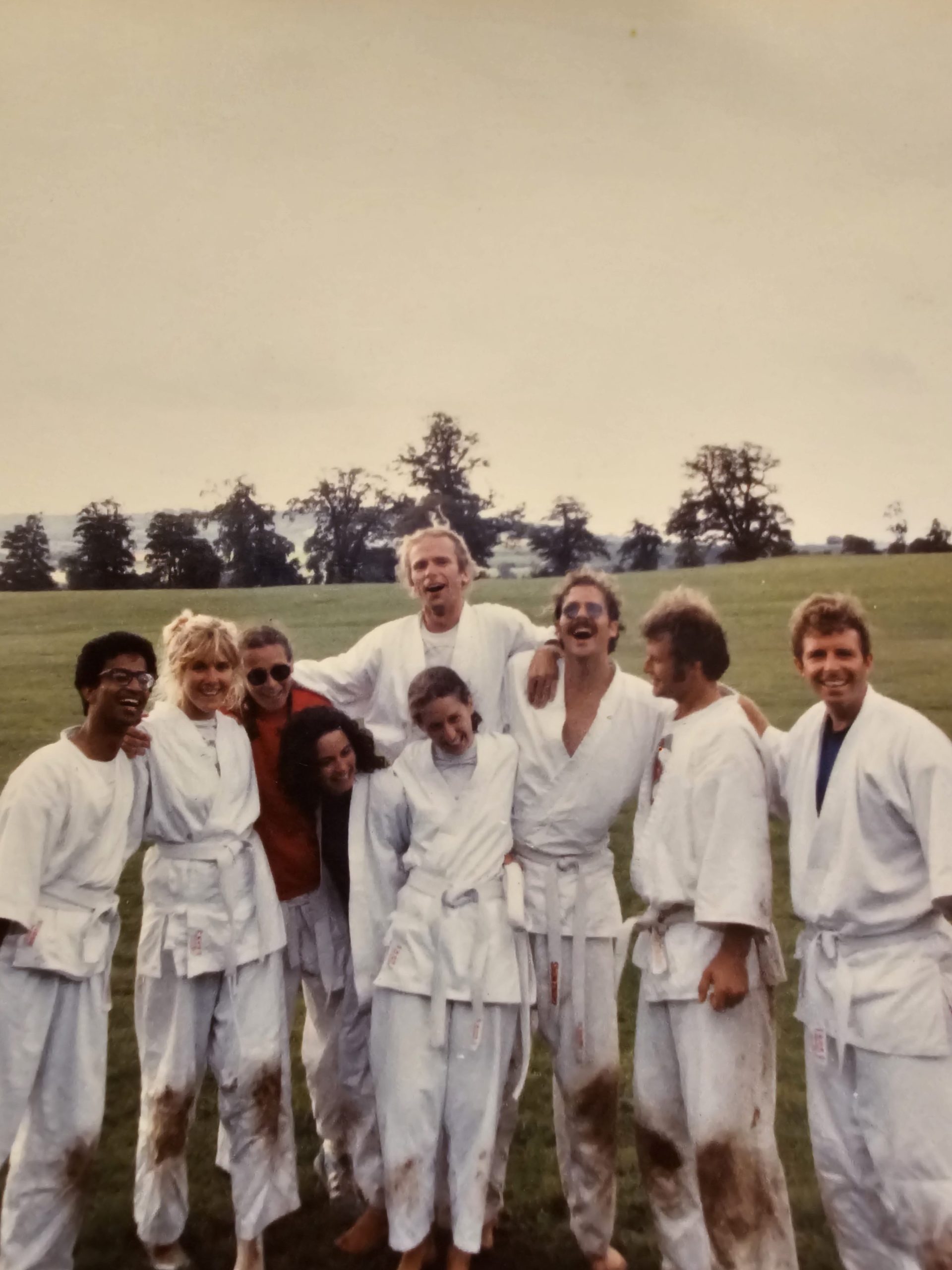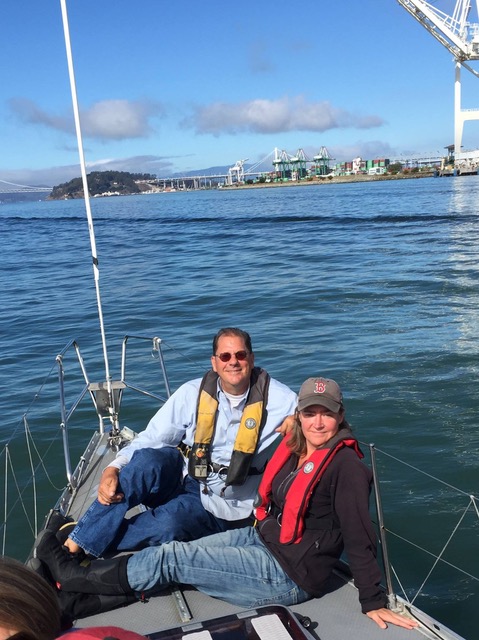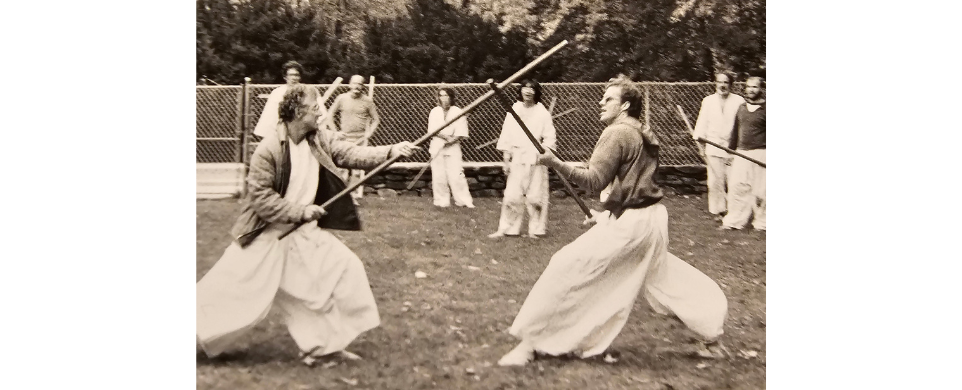by Tom Abbott
I started my Shintaido practice in 1975 in San Francisco. I studied Shintaido under Master Ito and Michael Thompson for 5 years, then taught it for 10 years in Massachusetts. For the past 30 years, I have done Shintaido for and by myself. Shintaido is in my body, and I find joy in expressing it. Shintaido has made me a better person in life, in my relationships, my work, my tennis and my sailing. I am open and empathic toward others, can focus, learn and adapt to change and take risks due to my Shintado experience. After all these years, it is still animating my life.
Today, my Shintaido practice is about opening, stretching and quietly expressing my energy and imagination. I find power spots where I can let Shintaido open the world around me. My practice starts by stretching and warming-up slowly with soft and steady progressions of stretching and squats. Nature is my Shintaido partner.
What I do is based on Tenshingoso, the essence of which is the simplicity of the five forms. As we all know, Tenshingoso can be done alone, sitting or standing, with a partner, in a group, or with nature. The 5 movements are a distillation of karate movements, with an overlay of 5 universal vowel sounds. The initial “Ah” is unique to Shintaido. Each movement starts with a sound and the result is a powerful and almost infinite sequence of movements, sounds and variations. Studying these movements lead to deep insight into one’s physical and spiritual development.
Using my imagination, I practice with elements of nature, such as trees or wind in a fluid, dynamic kata. I have developed three main katas for my practice. I often start with a compass-kata, just simple Ah-A, where I cut into the furthest and tallest tree in the distance, then move to the right 10 degrees, and cut again, until I complete a 360 degree embrace of the world around me. I extend my energy and touch the world around me. If I feel a connection with a tree, I do tree-kata, where the tree is my partner. I follow the flow of the trunk, the branches. I start with Ah and then relax and open wide into an Oh, feeling the shape of the canopy of trunks, branches, and leaves, then move into A, cutting down through the trunk, and continue into E, feeling the roots, then oh, to embrace the whole tree. If it is windy , I do a wind-kata. I let the wind talk to me, and it becomes my partner. I turn toward the wind and embrace it with an open Ah, and then I cut with A into the wind with my arms as swords, vertically, diagonally and horizontally. At this point, I have moved beyond form, I just let my body flow into a feeling and go with it. For example, I might open up with an E and that flows into an A. I also study sequences such as E-A, and Ah-E.
I also have an active meditation based on a combination of breathing exercises and mantras. My breathing is the basic technique of a long exhale, quick inhale, and pause for a random number of seconds, letting the rib muscles relax and allowing my lungs to settle down into the diaphragm. I pause here, and then breath out slowly to a count of 10. This process of Inhale-Hold-Exhale process is repeated over and over. centers and calms my mind. I do it at any time of day, as needed. During the day, when I am under great stress, I will make a gentle humming sound. In the afternoon, under the guise of taking a nap, I meditate for about 45 minutes, getting to deep relaxed state for about 10 minutes, and then I am refreshed. And at night, I do it to fall asleep. I find some combination of Japanese sounds, such as Ah-A-E-O-Um, counting in Japanese, or the Zen mantra, nam meoto renge kyo, will always calm my mind. Sometimes while falling asleep, I will feel Ah, and my body will relax, or I hold one sound, like E for an extended period of time, until I forget and fall asleep.
Ito was my instructor in San Francisco starting in 1975, assisted by Michael Thompson. I respected Ito as my Sensei and learned a great deal from him about Zen, Japanese culture, and martial arts in general. Friends of mine, including Jim Sterling, Pamela Olton and Steven Pizzella, started practicing with Ito, and eventually I joined them. Richard Rappaport and Bela Breslau started to practice along with many others. Over the years, we had a moderate group of about 50 serious students.
Ito used to say, the body needs to warm-up before it is ready to do Shintaido. We had 3 dojos, a small dance studio on Clement Street, a big open room at the American Can Factory, and a baseball field in Golden Gate Park, near 7th Ave. Ito developed a distinct practice for each dojo. A typical Friday night class with Ito started with pure karate, stretching, hoping, jumping, and various kata. Once our body had burned-off excess energy, our egos had relaxed, and spirits opened-up, we were ready for Shintaido, starting with Tenshingoso, at first standing individually, and then, sitting in kumite with partners. Then, we would progress into standing Tenshingoso partner kumite, cutting and rolling. It was timeless. After most classes, we would find a place to eat on Clement Street, or sometimes, Ito would cook a Japanese stew for everyone.

I moved back to Massachusetts in 1980 with my wife, Adrienne, who also did Shintaido. I had graduated from SF State with a degree in Sociology, and we wanted to start a new life together grounded in nature. Adrienne aspired to become a full-time potter with a studio, wheel and kiln. I got a job in Worcester, Mass., and we bought a house in Holden with 20 acres at the end of a dirt road. I approached the local, Greendale YMCA about teaching a new martial art, and they said yes, and offered me an underutilized studio, twice a week. This became my dojo for 10 years. At the peak, I had 25 active students. I loved every minute of it.
Serious students emerged, such as Joe and Deb Zawielski, Kesh and Annelie Narayanan, along with Bill Burtis and Michelle. Eventually we moved classes outside in summer months to practice on a large field, next to a lake outside the Y, where we could do Eiko-dai. We did occasional weekend retreats, where Ito or Michael would teach. I taught seminars on Shiatsu for Couples to raise money so I could travel to gasshukus in England and France. It was a dynamic time of my life. Eventually, one of my students found an apartment in Cambridge for Michael, and he moved east, and started teaching at Harvard, and doing weekend seminars.
Shintaido is a tool to release a powerful, creative and imaginative energy, but as a Shintaido Instructor, it was a challenge to explain it. I would compare it to other practices that people knew about. For instance, Shintaido is a blend of Karate, Tai Chi, Aikido, Yoga and Sword. I would explain the connections, that karate has katas, TaiChi the soft hand, and Aikido the dynamic partner kumite. I would say, Shintaido is a dynamic, moving yoga. Shintaido is based on sword practice, but without the sword. Shintaido uses the wooden sword and a long wooden stick, because real, metal swords are too dangerous. Shintaido used an open hand, and the arm becomes a sword. The open hand is stronger than a closed fist.
Shintaido evolved out of Shotokai Karate, into a practice that was beyond fighting, but still grounded in karate warm-up techniques and kata. It is not really a martial art any more. Tenshingoso kumite with partners is based on cooperation rather than competition. Taking a partner’s wrists to follow their lead enables a leader and follower relationship, that can be reversed, and become very dynamic. As a sword-based practice, students stretch their arms out as if they were a sword, with open hands the blade, and extend energy out to cut into our partner’s bodies, feeling for their center. We cut without effort, and without ego. The follower allows themselves to be cut, to be vulnerable, letting go of resistance, fear and insecurities.
I believe that Shintaido leads to deep insight into the body. The student learns that the body is stronger than the mind. Shintaido opens the body by releasing the grip of the unhealthy ego, and has the potential to burn away the trauma, drama and pain of being human.
I loved teaching Shintaido but there came a point after 10 years, where I had to stop teaching. I needed surgery on both knees to clean-up torn cartilage. It was hard to stop teaching Shintaido, but I was ready to make Shintaido mine, to bring it into my body directly, to become my own student. I lived on the edge of an open space, and I would run in the woods and cut the trees with a stick. I was mad at Shintaido for ruining my knees, but eventually came to accept that they were my knees, and I got good use of them doing Shintaido. I now understand that knee problems are common across all martial arts. I recovered enough to resume being a healthy and active person, playing tennis and sailing.

Eventually, in 1992, Adrienne and I decided to move back to California and I pursued a new career in technology in Silicon Valley. I joined a Men’s 4.0 Doubles Tennis Team and loved competing in doubles. And I started to learn to sail with my father.
Adrienne passed away in 2014, after losing her battle with early-onset of Alzheimer’s. I retired shortly thereafter and sailed more than 12,000 miles, to Hawaii three times and to Tahiti. I am now living in Alameda, and working as a sailing instructor. I still do Shintaido every day. I had knee replacement surgery in July, and my Shintaido practice has been the key to my recovery.
This article is a result of thinking about what Shintaido means to me. I moved beyond Shintaido, but Shintaido still flows out of me. My life has been informed and enhanced by Shintaido. It is my private practice and my secret weapon in life. Even though my body is now 70+ years old and I can’t run any more, I feel it…
I feel ready to re-connect with the larger Shintaido community again.



